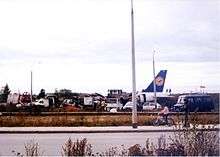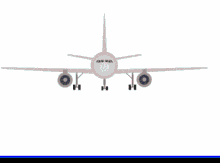Lufthansa Flight 2904
Lufthansa Flight 2904 was an Airbus A320-200 which overran the runway at Okęcie International Airport on 14 September 1993. It was a flight from Frankfurt, Germany to Warsaw, Poland.
 Wreckage of Flight 2904 on 15 September 1993 | |
| Accident | |
|---|---|
| Date | 14 September 1993 |
| Summary | Overshot runway due to pilot error |
| Site | Okęcie International Airport, Warsaw, Poland 52°09′39″N 20°59′07″E |
| Aircraft | |
| Aircraft type | Airbus A320-211 |
| Aircraft name | Kulmbach |
| Operator | Lufthansa |
| Registration | D-AIPN |
| Flight origin | Frankfurt Airport, Frankfurt, Germany |
| Destination | Okęcie International Airport, Warsaw, Poland |
| Occupants | 70 |
| Passengers | 64 |
| Crew | 6 |
| Fatalities | 2 |
| Injuries | 56 [1] |
| Survivors | 68 |
Incident description
.jpg)

Lufthansa Flight 2904 was cleared to land at Okęcie International Airport Runway 11 and was informed of the existence of wind shear on the approach.[1] To compensate for the crosswind, the pilots attempted to touch down with the aircraft banked slightly to the right. Additionally they landed with a speed about 20 knots (37 km/h; 23 mph) faster than usual. According to the manual, this was the correct procedure for the reported weather conditions, but the weather report was not up-to-date. At the moment of touchdown, the assumed crosswind turned out to be a tailwind. Due to the tailwind of approximately 20 knots (37 km/h; 23 mph) and the increased speed, the airplane hit the ground at approximately 170 knots (310 km/h; 200 mph) and far beyond the normal touch down point. The aircraft's right gear touched down 770 metres (2,530 ft) from the runway threshold. The left gear touched down 9 seconds later, 1,525 metres (5,003 ft) from the threshold. Only when the left gear touched the runway did the ground spoilers and engine thrust reversers start to deploy, these systems depending on oleo strut (shock absorber) compression. The wheel brakes, triggered by wheel rotation being equal to or greater than 72 knots (133 km/h; 83 mph), began to operate about 4 seconds later.
The remaining length of the runway (left from the moment when braking systems had begun to work) was too short to enable the aircraft to stop. Seeing the approaching end of the runway and the obstacle behind it, the pilot steered the aircraft off the runway to the right. The aircraft departed the runway at a speed of 72 knots (133 km/h; 83 mph) and rolled 90 metres (300 ft) before it hit the embankment and an LLZ aerial with the left wing. A fire started in the left wing area and penetrated into the passenger cabin.[2] Two of 70 occupants died in this accident, including the training captain (seated in the right seat) who died on impact and one passenger who was unable to escape because he lost consciousness as a result of the smoke in the cabin.
Causes of the accident
The main cause of the accident was incorrect decisions and actions of the flight crew.[1] Some of the incorrect decisions were taken when information about wind shear was received by the crew. The wind shear was produced by the front passing over the airport, accompanied by intensive variation of wind parameters as well as by heavy rain on the runway itself.
One additional cause was the lack of current wind information at the tower. For that reason no up-to-date wind information could be transmitted to the crew.
Further additional causes were certain design features of the aircraft. Computer logic prevented the activation of both ground spoilers and thrust reversers until a minimum compression load of at least 6.3 tons was sensed on each main landing gear strut, thus preventing the crew from achieving any braking action by the two systems before this condition was met.
Aircraft systems
To ensure that the thrust-reverse system and the spoilers are only activated in a landing situation, the software has to be sure the airplane is on the ground even if the systems are selected mid-air. The spoilers are only activated if at least one of the following two conditions is true:
- there must be weight of at least 6.3 tons on each main landing gear strut
- the wheels of the plane must be turning faster than 72 knots (133 km/h; 83 mph).
The thrust reversers are only activated if the first condition is true. There is no way for the pilots to override the software decision and activate either system manually.
In the case of the Warsaw accident neither of the first two conditions was fulfilled, so the most effective braking system was not activated. Point one was not fulfilled because the plane landed inclined (to counteract the anticipated crosswind). Thus the pressure of 12 tons on both landing gears combined required to trigger the sensor was not reached. Point two was not fulfilled either due to a hydroplaning effect on the wet runway.
Only when the left landing gear touched the runway did the automatic aircraft systems allow the ground spoilers and engine thrust reversers to operate. Due to the braking distances in the heavy rain the aircraft could not stop before the end of the runway. The computer did not actually know the aircraft had landed until it was already 125 meters beyond the halfway point of runway 11.

Passengers and crew
As a result of the impact a fire broke out and penetrated into the cabin, killing one of the passengers. The second pilot also died as a result of the collision. 51 people were seriously injured (including 2 crew members), 5 slightly injured.
See also
- Air France Flight 358, an Airbus A340 (F-GLZQ) which overran the runway and crashed in 2005 at Toronto Pearson International Airport.
- TAM Airlines Flight 3054, an Airbus A320 (PR-MBK) which overran the runway and crashed in 2007 at São Paulo–Congonhas Airport.
References
- "A320-211 Warsaw Accident Report". www.rvs.uni-bielefeld.de. Retrieved 12 September 2019.
- Ranter, Harro. "ASN Aircraft accident Airbus A320-211 D-AIPN Warszawa-Okecie Airport (WAW)". aviation-safety.net. Retrieved 12 September 2019.
External links
- Accident description at the Aviation Safety Network
- "Report on the Accident to Airbus A320-211 Aircraft in Warsaw on 14 September 1993" (Archive) – Main Commission Aircraft Accident Investigation
- Appendices (Archive) – CVR transcript, Documentation of the Braking System, excerpt from the Lufthansa A320 operating manual